watchOS 9 Adds Health and Fitness Features
Apple’s watchOS 9, unveiled at the company’s Worldwide Developers Conference, focuses on enhancing the Apple Watch’s health and fitness capabilities while, as usual, adding a batch of watch faces and interface enhancements.
Let’s look first at what we think are the standout watchOS 9 features and then move on to less compelling changes.
New Medications App
This all-new Apple Watch app—with complementary functionality in the iPhone’s Health app—is aimed at those who juggle multiple medications and worry about forgetting to take them when they are supposed to.
After you enter your medications, vitamins, and supplements into the Health app, you can see information about each on the iPhone or Apple Watch, plus set up schedules and reminders. Health will also alert users in the United States if “critical interactions” among two or more meds create a potential health risk.
We’re very much looking forward to trying Medications—it’s all too common to end up taking multiple pills per day, and any assistance in avoiding interactions and missed doses will be welcome.
Active Apps Pinned in Dock
Few Apple Watch features are more important than the Dock, which lets users access recently used or favorite apps with a press of the watch’s side button.
watchOS 9 adds a brilliant little tweak: apps that are actively in use now appear above the rest of the apps in the Dock, making it easier to return to them quickly.
Four New Watch Faces
There’s a reason new watch faces always figure prominently into watchOS unveils—who doesn’t love ‘em? (OK, they’re always worth checking out, even if you always go back to Infograph Modular like many of the TidBITS staff.) watchOS 9 has four new and revamped faces:
- Lunar, which depicts the relationship between the Gregorian calendar and the lunar calendar used in many cultures
- Playtime, which displays dynamic, whimsical art created in collaboration with artist Joi Fulton
- Metropolitan, a type-driven watch face within which fonts morph as you rotate the Digital Crown
- Astronomy, an existing face that Apple remastered with added features such as a star map and current cloud data
Apple also announced a grab bag of improvements to existing faces. Complications got facelifts in the Utility, Simple, and Activity Analog faces. Background color editing is now available in the Modular, Modular Compact, and X-Large faces.
But third-party developers still can’t create their own faces.
AFib History
The Apple Watch’s ECG app, along with its irregular rhythm notifications, has been able to identify potential signs of atrial fibrillation (or AFib) for a while. Left untreated, AFib is a health factor among those who suffer strokes.
With watchOS 9, users diagnosed with AFib will be able to monitor that condition over time, assuming Apple’s FDA approval comes through. The AFib History feature estimates how frequently a user’s heart rhythm shows worrisome patterns and gives users weekly notifications so they can keep track.
For Users with Disabilities
A recent watchOS feature called Quick Actions lets a user with disabilities control their Apple Watch with physical gestures such as a finger pinch or fist clench. As Apple announced a few weeks ago (see “Apple Previews Upcoming Accessibility Features,” 17 May 2022), watchOS 9 extends the feature to actions such as answering or ending a call, taking a picture, playing or pausing media, and controlling a workout.
In addition, watchOS 9 adds a feature called Apple Watch Mirroring for those with physical or motor disabilities. It allows a user to control their Apple Watch remotely using a paired iPhone. This is possible with voice input, head tracking, external Made for iPhone switches, and more.
Workout App Enhancements
watchOS’s Workout app, which is the primary reason many people have an Apple Watch, has been updated with better metrics for measuring athletic performance and new tools for attaining fitness goals.
For starters, the familiar in-session workout screen now harnesses the Digital Crown to cycle through various at-a-glance workout views.
Heart Rate Zones, which can be created manually or generated based on health data, can be helpful for monitoring the intensity of a workout, although you should be aware that heart rate can vary based on recovery state, sleep, or illness, so it’s not always a reliable fitness metric.
A new Custom Workouts feature is handy for those engaged in interval training since it lets you create a structured workout that includes active and passive stages.
Cardio Recovery is a useful fitness metric that can be an indicator of cardiovascular health. Apple Watch now offers Cardio Recovery estimates after an Outdoor Walk, Run, or Hiking workout, even when you don’t reach peak intensity.
For Runners
The Apple Watch is already popular among runners despite its awkward physical design, and watchOS 9 adds significant functionality that puts it more on par with running-specific watches from the likes of Garmin.
New running form data such as stride length, ground contact time, and vertical oscillation can be added as metrics in Workout Views. These appear in the Fitness app summary and in the iPhone’s Health app, where you can see trends over time and learn from patterns. Or at least that’s the theory—it’s hard for most people to change their running form without active coaching. We’ll see how these metrics compare with those from other systems that rely on foot or waist sensors.
The Workout app also remembers frequently used routes, and you can race against your best or last result and get alerts during a workout for being ahead or behind your pace, or if you’re veering off-route. A new pacer feature lets you choose a distance and goal for the time in which you want to complete a run, and it calculates the pace required to achieve your goal. During the workout, you can follow pace alerts and related metrics.
As noted, these features make the Apple Watch significantly more competitive with running-specific watches, and TidBITS publisher Adam Engst, who wears both his Apple Watch Series 5 and Garmin Forerunner 645 (with waist pod) on all runs, will be putting them through their paces soon.
More Health and Fitness Features
- For swimmers, watchOS 9 adds kickboard detection as a stroke type for Pool Swim workouts, and it lets swimmers track their efficiency with a SWOLF score—a stroke count combined with the time it takes to swim a pool length.
- For Apple Fitness+ users, workouts now show on-screen guidance. Metrics include Intensity for HIIT, Cycling, Rowing, and Treadmill; Strokes per Minute for Rowing; Revolutions per Minute for Cycling; and Incline for Treadmill walkers and runners.
- For triathletes, the Workout app now supports a new Multisport workout type that automatically switches between swimming, biking, and running workouts, using motion sensors to recognize movement patterns.
- For snoozers, watchOS 9 introduces a sleep-tracking metric called sleep stages. Using signals from the accelerometer and heart rate sensor, the Apple Watch can detect when users are in REM, Core, or Deep sleep, with data viewable in the Sleep app.
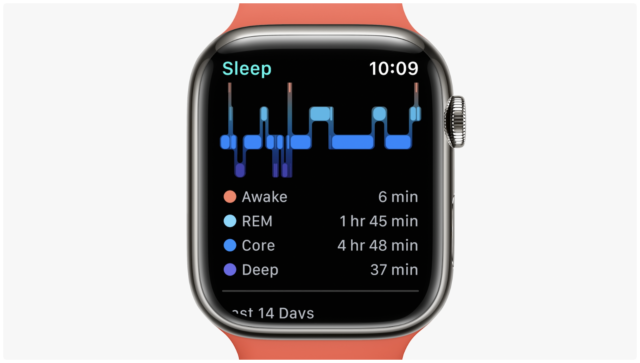
Additional watchOS 9 updates
- For those craving new podcasts, the watch’s Podcasts app now has integrated discovery. Find your next favorite show using the search or discovery functions. We suspect most people will continue to do this on the larger iPhone screen.
- Kids get more Apple Watch control in Family Setup scenarios. Parents can invite them to control HomePod speakers and other smart-home gadgets, and they can use home keys and hotel keys in Wallet. Kids also gain access to the Podcasts app.
- The QWERTY keyboard on Apple Watch Series 7 adds support for French, German, Italian, Japanese, Portuguese (Brazil), and Spanish (Mexico, Spain, and Latin America).
- The Calendar app now lets you create new events directly on the watch. You can access a Week view in addition to updated List, Day, and Month views.
- Other interface tweaks include a refreshed Siri user interface and new banner-style notifications.
As has been the case for the last few major watchOS updates, watchOS 9 strikes us as entirely welcome without being earth-shattering. It seems like a fine upgrade that will enhance but not revolutionize the Apple Watch experience.
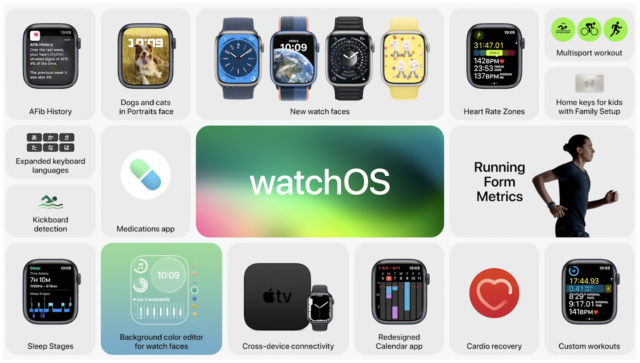
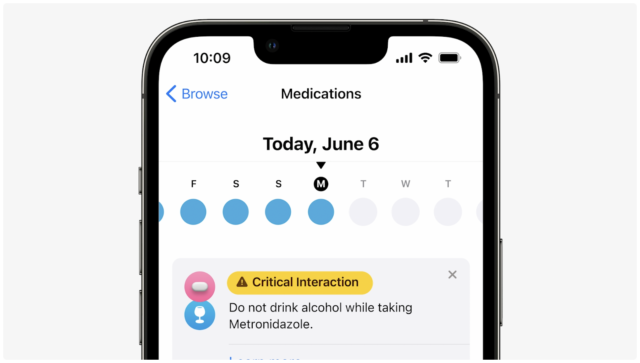
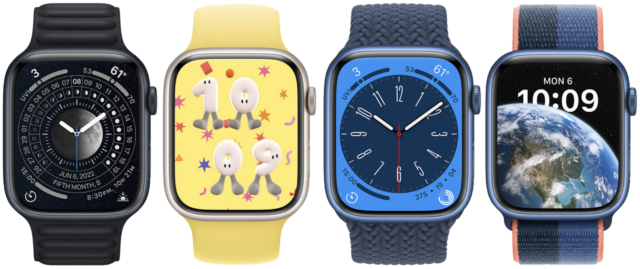
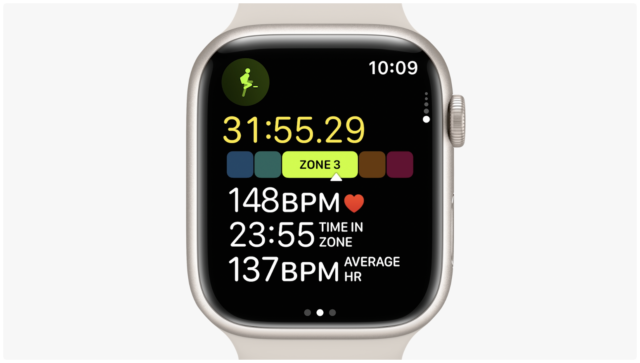
I’ll be interested to see how the kickboard addition is. In a typical swim I’ll do 400-500 metres of kicking and it always kinda annoyed me it didn’t track the lap if I wasn’t swinging my arms. Same with when doing life-saving practice like side-stroke or rescue backstroke (frog kick).
It’s really a trivial issue but it’s nice they’re trying.
What I’d REALLY like to see is a Health app on the Mac. Totally frustrating to try and navigate results on the tiny phone screen. I hate it.
For running I’l looking forward to the Running Power feature, this could mean that I don’t have to pay for and use the Stryd foot pod for that feature.